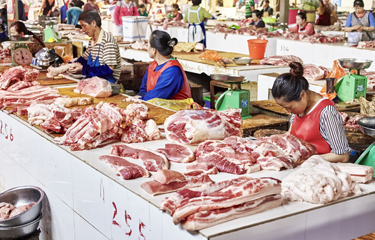A structural decline in China’s pork consumption, being driven by the country’s changing demographics as well as health concerns and rising incomes, will benefit the seafood industry, according to Bu Rui Ke (which also trades as China Brick), a research consultancy focused on agricultural commodities and publicly listed agricultural and food firms.
However, the firm found seafood is facing a battle with beef to become the protein of choice among the fast-growing, higher-spending Chinese middle class.
Average Chinese per capita pork consumption hit a peak of 42 kilograms per person in 2014 – up from 11.7 kilograms in 1981 - but that figure has since slid to below 40 kilograms, despite a dramatic drop in pork prices upon the recovery of the national hog herd from late 2021 in the wake of a devastating African swine flu pandemic.
Pork has long been considered the bedrock protein of the Chinese diet, and is typically cheaper than seafood. With price being a primary motivator for Chinese consumers, seafood has often lost out, but the correlation between the two appears to have become unhitched as the average Chinese income has risen, giving more consumers the ability to choose seafood as a healthier dietary option.
China’s aging population is one of the drivers of a shift toward seafood, as well as beef and chicken, according to Bu Rui Ke, which identified growing demand among older consumers and urban youth for health-conscious proteins. China consumed 9.98 million tons of beef in 2021, of which nearly a third was imported. The country’s beef imports last year rose 10 percent year-on-year to 2.34 million tons and are up tenfold over 2016 levels.
China’s seafood imports in 2021 totaled 5.71 million tons – a figure that includes both inputs for processing and products not for human consumption, such as fishmeal – a year-on-year increase of 0.72 percent. The country’s seafood exports were down 5.62 percent to 3.59 million tons.
Not all seafood imported by China was consumed, as a significant portion of China’s seafood imports were then processed and reexported. But among China’s seafood imports, the fastest-growing segment in 2021 was high-value product for domestic consumption. That growth hasn’t been too badly hurt by average seafood prices rising 8.8 percent year-on-year in January and 4.9 percent in February, or by a 41.6 percent drop in pork prices prompted by an ongoing recovery of the national herd from swine flu.
Longer-term, China’s seafood imports have risen from 1.03 million tons in 1992 to 5.9 million tons in 2018, with a surge in value from CNY 6.8 billion (USD 1.02 billion, EUR 884 million) to CNY 80.2 billion (USD 12 billion, EUR 10.4 billion) in the same timeframe. China's seafood imports were worth USD 14.15 billion (EUR 13.3 billion) in 2021, up from USD 12.7 billion (EUR 11.6 billion) in 2020 but well off the USD 15.8 billion (EUR 14.5 billion) recorded in 2019. In 2018, China recorded USD 11.9 billion (EUR 10.9 billion) worth of seafood imports.
China’s seafood output – the combined total volume of seafood produced via aquaculture and wild-capture fisheries – will amount to 69 million metric tons (MT) tons in 2025, according to China’s State Council which published its target in February 2022 in a document titled “Announcement of Modernization of Chinese Agriculture Under the 15th Five-Year Plan.” The total is up from 2021, when China’s seafood production reached 66.9 million tons, which itself was up 2.2 percent year-on-year from 2020. Farmed production accounting for 53.8 million tons of the total figure in 2021. Comparatively, the plan calls for 55 million metric tons of pork production by 2025.
The eclipsing of pork by seafood has prompted a surge in interest in seafood stocks among the country’s many retail investors, who have also watched as the Chinese government has issued numerous policies to support the continued growth of the country’s aquaculture and distant-water fishing operations.
However, according to the Bu Rui Ke report, there is room for China’s pork producers to regain market share by switching focus to higher-value products. China’s pork industry is far more consolidated than its seafood sector, making this task easier. The top ten Chinese companies ranked by aquaculture production account for only 2 percent of national aquaculture output, according to Liu Hanyuan, the boss of the Tongwei Group, a large aquafeed and aquaculture firm, yet the 10 largest pig firms have a market share of 12 percent. The top 10 poultry companies have a market share of 40 percent.
Inequity in China’s tax policy is preventing the aquaculture sector from achieving scale and standardized operations, Liu said at last month’s National People’s Congress in Beijing. A tax on wholesale fish sales is preventing consolidation in the sector hurts the seafood industry, especially as highly integrated pork and poultry processors aren’t exposed to similar taxes because they breed their own animals in-house, Liu said.
Photo courtesy of Maciej Bledowski/Shutterstock







